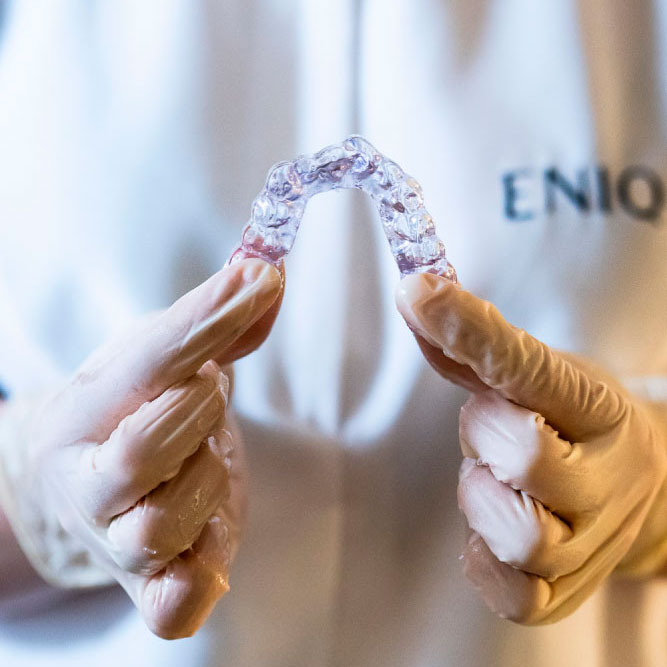

Invisible Orthodontics
An aesthetic and comfortable solution to discreetly align your teeth.
What is Invisible Orthodontics?
Invisible orthodontics is a modern and aesthetic approach to correct the position of teeth and improve jaw alignment. It's also known as transparent orthodontics or clear aligners. Unlike traditional metal braces, invisible orthodontics uses a series of transparent and removable aligners custom-made for each patient.
These aligners are made from a transparent plastic material and are placed over the teeth, exerting gentle pressure to gradually move the teeth to their desired position. Each set of aligners is used for approximately two weeks before being replaced by the next set in the series. As different sets are used, the teeth progressively move towards the final position planned by the orthodontist.
Invisible orthodontics offers several advantages compared to traditional braces. Firstly, the aligners are virtually invisible, making the treatment aesthetically more pleasing. Additionally, the aligners are removable, which makes teeth cleaning easier and allows for unrestricted eating and drinking. However, it's important to note that the aligners should be worn for most of the day, at least 20-22 hours daily, for the treatment to be effective.
It's important to highlight that invisible orthodontics may not be suitable for all cases of dental misalignment. Some more complex issues may require other types of orthodontic treatment. It's advisable to consult with a certified orthodontist to determine if invisible orthodontics is a viable option to correct the position of your teeth.
What is the process of invisible orthodontics, and how many visits are necessary?
The process of invisible orthodontics generally follows these steps:
- Initial consultation: Schedule an appointment with an orthodontist experienced in invisible orthodontics to evaluate your case and discuss your goals.
- Treatment planning: Create a detailed treatment plan using specialized software to visualize tooth movement.
- Manufacturing of aligners: Manufacture a series of custom transparent aligners in an advanced dental laboratory.
- Using the aligners: Use each set of aligners as instructed, typically between 20 and 22 hours a day, to gradually move the teeth.
- Follow-up visits: Attend regular appointments with the orthodontist to assess progress and make adjustments if necessary.
- Completion of treatment: Use all aligners until the desired position of the teeth is achieved and follow post-treatment recommendations.
The duration of the treatment varies depending on the complexity of the case, and it's essential to follow the orthodontist's instructions and maintain good oral hygiene throughout the process.
Innovation
What are the advantages of invisible orthodontics?
Invisible orthodontics, also known as transparent orthodontics or clear aligners, offers several advantages compared to other orthodontic treatment methods.
Some of the advantages of invisible orthodontics include:

- Aesthetics and Comfort: Transparent and smooth aligners that offer discreet dental correction and reduce discomfort.
- Hygiene and Convenience: Removable for easy cleaning and eating, simplifying oral hygiene routines.
- Optimized Visits: Reduced frequency of required appointments with the orthodontist, with home monitoring.
- Unaltered Lifestyle: Allows you to continue daily activities without speech interference or dietary restrictions.
It's important to note that invisible orthodontics may not be suitable for all cases of dental misalignment. The choice of the appropriate treatment method will depend on the assessment and recommendation of the orthodontist, taking into account the complexity of the case and the individual needs of the patient.

What are the brands of invisible orthodontics?
There are several prominent brands in the market:
- Invisalign: Recognized and pioneering with custom transparent aligners to correct dental alignment.
- Spark: Introduced in 2020, it has received excellent reviews for its innovations and effectiveness in invisible orthodontics.
- ClearCorrect: Another leading brand that provides a similar alternative to Invisalign with a global reach.
- SmileDirectClub: Offers online invisible orthodontic treatment with custom aligners sent directly to the patient.
- SureSmile: Combines 3D imaging technology with transparent aligners for a more precise and efficient approach.
- Smartee System: It combines the advantages of the two previous systems, enhancing them with its high technology. It uses a high-end ultra-transparent material, which provides greater aesthetics and effectiveness in the treatment.
Choosing the right brand should consider individual features, advantages, and recommendations from the orthodontist. Consulting a qualified orthodontist is essential to determine the most suitable option for each case.
Differences between the Spark and Invisalign systems?
- Greater retentive force: Spark provides superior retention force, which can result in shorter treatments and the ability to treat more complex cases.
- Greater transparency: Unlike Invisalign aligners, Spark introduced TruGEN™ material in 2021, offering greater transparency and free from BPA, mercury, latex, and phthalates.
- Polished edges: Spark stands out with a more refined polish compared to Invisalign, which can contribute to a more comfortable user experience.
- Polymer-to-tooth fit: Spark ensures closer contact between the aligner and the tooth, allowing for more effective movement at more points on the dental surface.
Invisible aligners for cases of different complexity:
- Invisalign: Offers solutions like Invisalign i7 and Lite for simple cases, and Comprehensive for more complex situations like severe crowding or malocclusions.
- Spark: Provides a range that includes Spark 10 for simple cases, Spark 20 for intermediate cases, and Spark Advanced for the most complex cases.
Software technology also makes a significant difference:
- With Invisalign, mainly the dental crown is visualized.
- Spark's software allows for integrating complete root anatomy for more detailed planning and preventing side effects like gingival recessions.
- Spark also offers the option to place attachments on the inner surface of the teeth and add posterior bite ramps to improve esthetic results.
In conclusion, while Invisalign provides outstanding results, Spark stands out for its clarity, superior polish, and more comprehensive planning that considers tooth roots to prevent potential complications.
Finally, the Smartee invisible orthodontics system emerges as a cutting-edge innovation, blending the qualities of previous systems and enhancing them to achieve ideal results.

Our Opinion on Invisible Orthodontics
We consider invisible orthodontics to be a highly effective treatment option, which often has an excellent success rate when patients carefully follow the orthodontist's instructions and commit to the treatment. Effectiveness may vary depending on the individual response of dental tissues and patient cooperation. We believe it is essential to choose a service provider who not only offers advanced technology but also a team of qualified professionals.
At ENIQ, we offer exactly that: a team of the best professionals and access to leading brands in invisible orthodontics, which have statistically proven to be successful. We are aware that cheaper options can be found in the market; however, they often involve lower quality of care and results that do not meet expectations. At ENIQ, our priority is to ensure that your investment in invisible orthodontics is effective and safe, providing you with the peace of mind of being in expert hands.
Dra. Alejandra de la Rosa
Medical Director
+90%
What Percentage of Success Does Invisible Orthodontics Have?
Invisible orthodontics has proven to be effective in treating various malocclusion problems, although a single success percentage cannot be specified due to the variability of each case. Success depends on the severity of malocclusion, the patient's consistency in using aligners, and adherence to the orthodontist's instructions.
Generally, if the orthodontist's instructions are followed, and follow-up visits are maintained, invisible orthodontics tends to have a high success rate. However, individual factors such as the response of dental tissues and patient cooperation are also crucial.
For an accurate assessment of treatment and its potential for success, it is essential to consult with a qualified orthodontist who can evaluate your specific situation.
What Are the Benefits of Getting ENIQ Guided Surgery Implants?
At ENIQ, we have the best professionals and the best brands with a high success rate in invisible orthodontics. Currently, many clinics offer low prices, but the care may be provided by an assistant and with brands that do not guarantee a successful treatment outcome. We recommend that you pay attention to these aspects when choosing where to have it done, as it is worth ensuring that your investment is secured.
What is the price of invisible orthodontics?
Regarding Invisalign, we can also distinguish between two treatments: Lite (for simpler cases) and Comprehensive (formerly known as Full), which is used for more complex malocclusions.
Once this distinction is made, we can say that in Spain, the price of Invisalign orthodontics ranges from €3,100 to €5,600.
Hybrid Prosthesis on Implants
Complete Solution
*subject to specialist evaluation
-
All-Inclusive
Frequently Asked Questions
Do you have more questions about invisible orthodontics?
Most people are candidates for invisible orthodontics, which is capable of correcting various types of malocclusions. This treatment modality is suitable for patients of all ages, including children, teenagers, and adults.
Both braces and invisible orthodontics offer similar treatment times and are equally effective. The decisive factor in the treatment duration is the complexity of the patient's malocclusion. More complex cases will require a longer treatment period.
Previously, certain complex malocclusions were not candidates for invisible orthodontics, but advances in the technique have expanded its scope. Currently, invisible orthodontics has been perfected to correct almost any challenge associated with dental alignment and occlusion.
The choice between invisible orthodontics and conventional braces depends on individual needs and preferences, as well as the professional recommendation of the orthodontist. Each method offers unique advantages and has its own considerations.
Advantages of invisible orthodontics: It offers superior aesthetics with virtually invisible aligners, greater comfort by avoiding wires and brackets, and it's removable for easy oral hygiene and eating.
Disadvantages of invisible orthodontics: It may be less effective for complex malocclusions, usually has a higher cost, and requires discipline for consistent aligner wear.
Advantages of conventional braces: They are more effective for treating complex malocclusions, are usually more cost-effective, and do not require the discipline of use like invisible orthodontics, as they are a fixed solution.
Considerations about braces: They have a less aesthetic appearance, can cause discomfort or soreness, and require more attention to oral hygiene and dietary restrictions.
The final decision between invisible orthodontics and braces should be based on a detailed analysis of your specific needs and guidance from a qualified orthodontist, considering effectiveness, aesthetics, comfort, and costs of each option.
Invisible orthodontics with transparent aligners is generally considered the least discomforting treatment. It is considered to be a generally painless orthodontic technique, both during placement and throughout the treatment.
It is true that invisible orthodontics involves a brief adjustment period, but this is typically shorter than that required for braces, usually lasting no more than three or four days.
Services
All rights reserved © ENIQ Clinic 2025
Legal Notice · Privacy Policy · Cookie Policy
